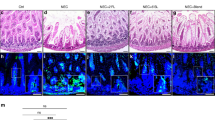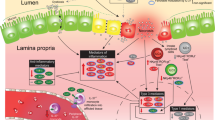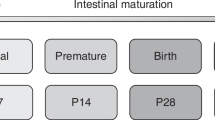Abstract
Background
Necrotizing enterocolitis (NEC) develops through exaggerated toll-like receptor 4 (TLR4) signaling in the intestinal epithelium. Breast milk is rich in non-digestible oligosaccharides and prevents NEC through unclear mechanisms. We now hypothesize that the human milk oligosaccharides 2’-fucosyllactose (2’-FL) and 6’-sialyllactose (6’-SL) can reduce NEC through inhibition of TLR4 signaling.
Methods
NEC was induced in newborn mice and premature piglets and infant formula was supplemented with 2’-FL, 6’-SL, or lactose. Intestinal tissue was obtained at surgical resection. HMO inhibition of TLR4 was assessed in IEC-6 enterocytes, mice, and human tissue explants and via in silico modeling.
Results
Supplementation of infant formula with either 2’-FL and/or 6’-SL, but not the parent sugar lactose, reduced NEC in mice and piglets via reduced apoptosis, inflammation, weight loss, and histological appearance. Mechanistically, both 2’-FL and 6’-SL, but not lactose, reduced TLR4-mediated nuclear factor kappa light-chain enhancer of activated B cells (NF-kB) inflammatory signaling in the mouse and human intestine. Strikingly, in silico modeling revealed 2’-FL and 6’-SL, but not lactose, to dock into the binding pocket of the TLR4–MD2 complex, explaining their ability to inhibit TLR4 signaling.
Conclusions
2’-FL and 6’-SL, but not lactose, prevent NEC in mice and piglet models and attenuate NEC inflammation in the human ileum, in part through TLR4 inhibition.
Impact
-
Necrotizing enterocolitis (NEC) is a major cause of morbidity and mortality in premature infants that occurs in the setting of bacterial colonization of the gut and administration of formula feeds and activation by the innate immune receptor toll-like receptor 4 (TLR4). Breast milk prevents NEC through unclear mechanisms. We now show that breast milk-enriched human milk oligosaccharides (HMOs) that are derived from lactose prevent NEC through inhibition of TLR4.
-
The human milk oligosaccharides 2’-FL and 6’-SL, but not the backbone sugar lactose, prevent NEC in mice and piglets.
-
2’-FL and 6’-SL but not lactose inhibited TLR4 signaling in cultured enterocytes, in enteroids derived from mouse intestine, and in human intestinal explants obtained at the time of surgical resection for patients with NEC.
-
In seeking the mechanisms involved, 2’-FL and 6’-SL but not lactose were found to directly bind to TLR4, explaining the inhibition and protection against NEC.
-
These findings may impact clinical practice by suggesting that administration of HMOs could serve as a preventive strategy for premature infants at risk for NEC development.
Similar content being viewed by others
Log in or create a free account to read this content
Gain free access to this article, as well as selected content from this journal and more on nature.com
or
References
Stoll, B. J. et al. Trends in care practices, morbidity, and mortality of extremely preterm neonates, 1993–2012. JAMA 314, 1039 (2015).
Fitzgibbons, S. C. et al. Mortality of necrotizing enterocolitis expressed by birth weight categories. J. Pediatr. Surg. 44, 1072–1076 (2009).
Martin, J. A. & Osterman, M. J. K. Describing the increase in preterm births in the United States, 2014-2016. NCHS Data Brief 1–8 (2018)
Leaphart, C. L. et al. A critical for TLR4 in the pathogenesis of necrotizing enterocolitis by modulating intestinal injury and repair. J. Immunol. 179, 4808–4820 (2007).
Sodhi, C. P. et al. Intestinal epithelial toll-like receptor 4 regulates goblet cell development and is required for necrotizing enterocolitis in mice. Gastroenterology 143, 708.e5–718.e5 (2012).
Gribar, S. C., Richardson, W. M., Sodhi, C. P. & Hackam, D. J. No longer an innocent bystander: epithelial toll-like receptor signaling in the development of mucosal inflammation. Mol. Med. 14, 645–659 (2008).
Jilling, T. et al. The roles of bacteria and TLR4 in rat and murine models of necrotizing enterocolitis. J. Immunol. 177, 3273–3282 (2006).
Gribar, S. C. et al. Reciprocal expression and signaling of TLR4 and TLR9 in the pathogenesis and treatment of necrotizing enterocolitis. J. Immunol. 182, 636–646 (2009).
Hackam, D. J., Good, M. & Sodhi, C. P. Mechanisms of gut barrier failure in the pathogenesis of necrotizing enterocolitis: toll-like receptors throw the switch. Semin. Pediatr. Surg. 22, 76–82 (2013).
Dheer, R. S. et al. Intestinal epithelial toll-like receptor 4 signaling affects epithelial function and colonic microbiota and promotes a risk for transmissible colitis. Infect. Immun. 84, 798–810 (2016).
Yazji, I. et al. Endothelial TLR4 activation impairs intestinal microcirculatory perfusion in necrotizing enterocolitis via eNOS-NO-nitrite signaling. Proc. Natl Acad. Sci. USA 110, 9451–9456 (2013)
Good, M. et al. The human milk oligosaccharide 2′-fucosyllactose attenuates the severity of experimental necrotising enterocolitis by enhancing mesenteric perfusion in the neonatal intestine. Br. J. Nutr. 116, 1175–1187 (2016).
Bering, S. B. Human milk oligosaccharides to prevent gut dysfunction and necrotizing enterocolitis in preterm neonates. Nutrients 10, 1461 (2018).
Autran, C. A., Schoterman, M. H. C., Jantscher-Krenn, E., Kamerling, J. P. & Bode, L. Sialylated galacto-oligosaccharides and 2′-fucosyllactose reduce necrotising enterocolitis in neonatal rats. Br. J. Nutr. 116, 294–299 (2016).
Livak, K. J. & Schmittgen, T. D. Analysis of relative gene expression data using real-time quantitative PCR and the 2(-Delta Delta C(T)) method. Methods 25, 402–408 (2001).
Kilkenny, C., Browne, W. J., Cuthill, I. C., Emerson, M. & Altman, D. G. Improving bioscience research reporting: the ARRIVE guidelines for reporting animal research. PLoS Biol. 8, e1000412 (2010).
Niño, D. F. et al. Cognitive impairments induced by necrotizing enterocolitis can be prevented by inhibiting microglial activation in mouse brain. Sci. Transl. Med. 10, eaan0237 (2018).
Sodhi, C. P. et al. Fat composition in infant formula contributes to the severity of necrotising enterocolitis. Br. J. Nutr. 120, 665–680 (2018).
Good, M. et al. Lactobacillus rhamnosus HN001 decreases the severity of necrotizing enterocolitis in neonatal mice and preterm piglets: evidence in mice for a role of TLR9. Am. J. Physiol. Gastrointest. Liver Physiol. 306, G1021–G1032 (2014).
Kim, H. M. et al. Crystal structure of the TLR4-MD-2 complex with bound endotoxin antagonist Eritoran. Cell 130, 906–917 (2007).
Bum-Erdene, K., Leffler, H., Nilsson, U. J. & Blanchard, H. Structural characterisation of human galectin-4 N-terminal carbohydrate recognition domain in complex with glycerol, lactose, 3’-sulfo-lactose, and 2’-fucosyllactose. Sci. Rep. 6, 20289 (2016).
Yamashita, S. et al. Carbohydrate recognition mechanism of HA70 from Clostridium botulinum deduced from X-ray structures in complexes with sialylated oligosaccharides. FEBS Lett. 586, 2404–2410 (2012).
Egan, C. E. et al. Toll-like receptor 4-mediated lymphocyte influx induces neonatal necrotizing enterocolitis. J. Clin. Invest. 126, 495–508 (2016).
Rudloff, S. et al. Incorporation of orally applied 13C-galactose into milk lactose and oligosaccharides. Glycobiology 16, 477–487 (2006)
Ahsan, H. 3-Nitrotyrosine: a biomarker of nitrogen free radical species modified proteins in systemic autoimmunogenic conditions. Hum. Immunol. 74, 1392–1399 (2013).
Afrazi, A. et al. Intracellular heat shock protein-70 negatively regulates TLR4 signaling in the newborn intestinal epithelium. J. Immunol. 188, 4543–4557 (2012).
Cetin, S. et al. Endotoxin inhibits intestinal epithelial restitution through activation of Rho-GTPase and increased focal adhesions. J. Biol. Chem. 279, 24592–24600 (2004).
Moukarzel, S. & Bode, L. Human milk oligosaccharides and the preterm infant: a journey in sickness and in health. Clin. Perinatol. 44, 193–207 (2017).
Musilova, S., Rada, V., Vlkova, E. & Bunesova, V. Beneficial effects of human milk oligosaccharides on gut microbiota. Benef. Microbes 5, 273–283 (2014).
Wu, R. Y. et al. Human milk oligosaccharides increase mucin expression in experimental necrotizing enterocolitis. Mol. Nutr. Food Res. 63, e1800658 (2019).
Acknowledgements
D.J.H. is supported by R01GM078238 and R01DK083752 from the National Institutes of Health, and this research was funded in part by a Sponsored Research Grant from Abbott Nutrition to D.J.H.
Author information
Authors and Affiliations
Contributions
Substantial contributions to conception and design, acquisition of data, analysis or interpretation of data: C.P.S., P.W., Y.Y., W.B.F., M.K., D.F.N., Q.Z., E.B., A.D.W., M.R.L., T.P., S.W., H.J., R.H.B., K.C.G., P.L., D.J.H.; drafting the article or revising it critically: C.P.S., R.H.B., K.C.G., D.J.H.; final approval of the version to be published: C.P.S., D.J.H., R.H.B., K.C.G.
Corresponding author
Ethics declarations
Competing interests
This work was supported in part by a sponsored research grant from Abbott Nutrition to DJH. No author has any financial relationship or conflict of interest with the current work.
Statement of consent
Samples were obtained de-identified under IRB 00094036 and consent was not required.
Additional information
Publisher’s note Springer Nature remains neutral with regard to jurisdictional claims in published maps and institutional affiliations.
Supplementary Information
Rights and permissions
About this article
Cite this article
Sodhi, C.P., Wipf, P., Yamaguchi, Y. et al. The human milk oligosaccharides 2’-fucosyllactose and 6’-sialyllactose protect against the development of necrotizing enterocolitis by inhibiting toll-like receptor 4 signaling. Pediatr Res 89, 91–101 (2021). https://doi.org/10.1038/s41390-020-0852-3
Received:
Revised:
Accepted:
Published:
Issue date:
DOI: https://doi.org/10.1038/s41390-020-0852-3
This article is cited by
-
Thrombin-preconditioned mesenchymal stromal cell-derived extracellular vesicles attenuate experimental necrotizing enterocolitis
Stem Cell Research & Therapy (2025)
-
Necrotizing enterocolitis: specific human milk oligosaccharides prevent enteric glia loss and hypomotility
Pediatric Research (2025)
-
Portal venous gas value in predicting surgical necrotizing enterocolitis
Pediatric Research (2025)
-
The role of NLRP3 inflammasome in necrotizing enterocolitis
Pediatric Research (2025)
-
Protecting the enteric brain (nervous system) in preterm infants: human milk oligosaccharides to the rescue
Pediatric Research (2025)



